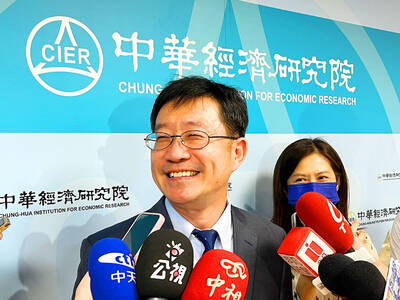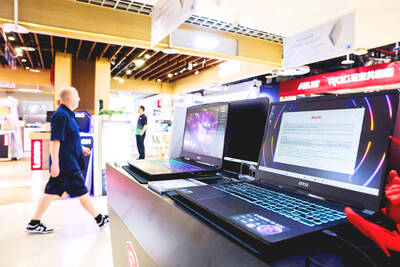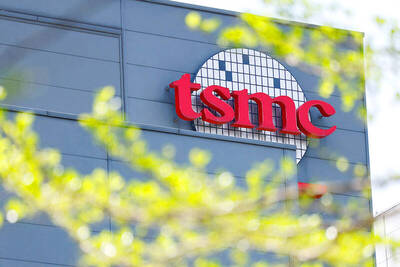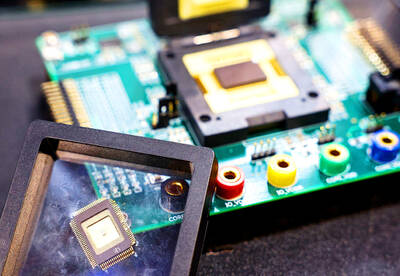Construction on Taipei's long-awaited Nangang Exhibition Hall is likely to miss its deadline again in April, an unfortunate turn of events for the nation's exhibition industry at a time when neighboring countries are gearing up to grab a share of the market with their mega-size expo venues.
The hall was originally scheduled for completion last June but had been delayed until April.
Construction has since fallen behind schedule and the completion date will likely be pushed back once again, an official at the Taiwan External Trade Development Council (TAITRA, 外貿協會), the hall operator, said during a telephone interview yesterday.
In the original plan, the hall would have been transferred to TAITRA in September and thereby facilitate preparations for next year's exhibitions.
TAITRA won the right last June to operate the Nangang hall for a period of 10 years.
TAITRA has sent an official document requesting a new completion date to the Bureau of Foreign Trade under the Ministry of Economic Affairs, which oversees construction of the hall, but has yet to receive a reply, a TAITRA official, who refused to be identified, said.
The Nangang Exhibition Hall is expected to open its doors for the first expo in March next year.
TAITRA has planned to house part of Computex Taipei -- the second-largest IT trade fair after Germany's CeBIT -- Food Taipei, Taipei Cycle, Taipei International Auto Parts and Accessories Show and the Taipei International Automobile Electronics Show in the new hall.
The three favored expo halls at the Taipei World Trade Center (TWTC) -- which can only accommodate a total of 2,500 booths -- located in the bustling Xinyi District, are no longer sufficient to host international expos.
In a bid to expand the scale of the exhibitions and compete with countries in the region, the Cabinet announced in June 2003 it would build the nation's largest expo and conference center in Nangang, with construction costs estimated at NT$3.6 billion (US$110 million), the TWTC Web site said.
The new hall, with seven floors and two underground levels -- for a total floor space of 47,000m2 -- will be able to accommodate more than 2,600 booths.
It nevertheless remains smaller than those found in China.
Hong Kong's exhibition center at Hong Kong International Airport, for example, was launched last year with a floor space of 66,000m2.
In line with Las Vegas' operational mode, Macau's new exhibition center will open its doors for business this year with a floor space of 74,000m2, a report in the Chinese-language Commercial Times said yesterday.
Expo halls in Shanghai, Dalian and Suzhou all have exhibition spaces of over 70,000m2, the report added.
South Korea, meanwhile, has decided to allot a piece of land of more than 10 hectares to build a large-sized exhibition venue.
Facing this type of competition, TAITRA said it hopes construction at Nangang Hall can be completed as soon as possible -- if not on time -- before pushing for a "second-generation" exhibition hall.
The "first-generation" hall under construction only occupies one-third of the land.
The remainder will be developed into hotels, shopping malls and offices, which should help turn Taiwan into a world-class expo location, TAITRA chairman Hsu Chih-jen (

WEAKER ACTIVITY: The sharpest deterioration was seen in the electronics and optical components sector, with the production index falling 13.2 points to 44.5 Taiwan’s manufacturing sector last month contracted for a second consecutive month, with the purchasing managers’ index (PMI) slipping to 48, reflecting ongoing caution over trade uncertainties, the Chung-Hua Institution for Economic Research (CIER, 中華經濟研究院) said yesterday. The decline reflects growing caution among companies amid uncertainty surrounding US tariffs, semiconductor duties and automotive import levies, and it is also likely linked to fading front-loading activity, CIER president Lien Hsien-ming (連賢明) said. “Some clients have started shifting orders to Southeast Asian countries where tariff regimes are already clear,” Lien told a news conference. Firms across the supply chain are also lowering stock levels to mitigate

IN THE AIR: While most companies said they were committed to North American operations, some added that production and costs would depend on the outcome of a US trade probe Leading local contract electronics makers Wistron Corp (緯創), Quanta Computer Inc (廣達), Inventec Corp (英業達) and Compal Electronics Inc (仁寶) are to maintain their North American expansion plans, despite Washington’s 20 percent tariff on Taiwanese goods. Wistron said it has long maintained a presence in the US, while distributing production across Taiwan, North America, Southeast Asia and Europe. The company is in talks with customers to align capacity with their site preferences, a company official told the Taipei Times by telephone on Friday. The company is still in talks with clients over who would bear the tariff costs, with the outcome pending further

Six Taiwanese companies, including contract chipmaker Taiwan Semiconductor Manufacturing Co (TSMC, 台積電), made the 2025 Fortune Global 500 list of the world’s largest firms by revenue. In a report published by New York-based Fortune magazine on Tuesday, Hon Hai Precision Industry Co (鴻海精密), also known as Foxconn Technology Group (富士康科技集團), ranked highest among Taiwanese firms, placing 28th with revenue of US$213.69 billion. Up 60 spots from last year, TSMC rose to No. 126 with US$90.16 billion in revenue, followed by Quanta Computer Inc (廣達) at 348th, Pegatron Corp (和碩) at 461st, CPC Corp, Taiwan (台灣中油) at 494th and Wistron Corp (緯創) at

NEGOTIATIONS: Semiconductors play an outsized role in Taiwan’s industrial and economic development and are a major driver of the Taiwan-US trade imbalance With US President Donald Trump threatening to impose tariffs on semiconductors, Taiwan is expected to face a significant challenge, as information and communications technology (ICT) products account for more than 70 percent of its exports to the US, Chung-Hua Institution for Economic Research (CIER, 中華經濟研究院) president Lien Hsien-ming (連賢明) said on Friday. Compared with other countries, semiconductors play a disproportionately large role in Taiwan’s industrial and economic development, Lien said. As the sixth-largest contributor to the US trade deficit, Taiwan recorded a US$73.9 billion trade surplus with the US last year — up from US$47.8 billion in 2023 — driven by strong